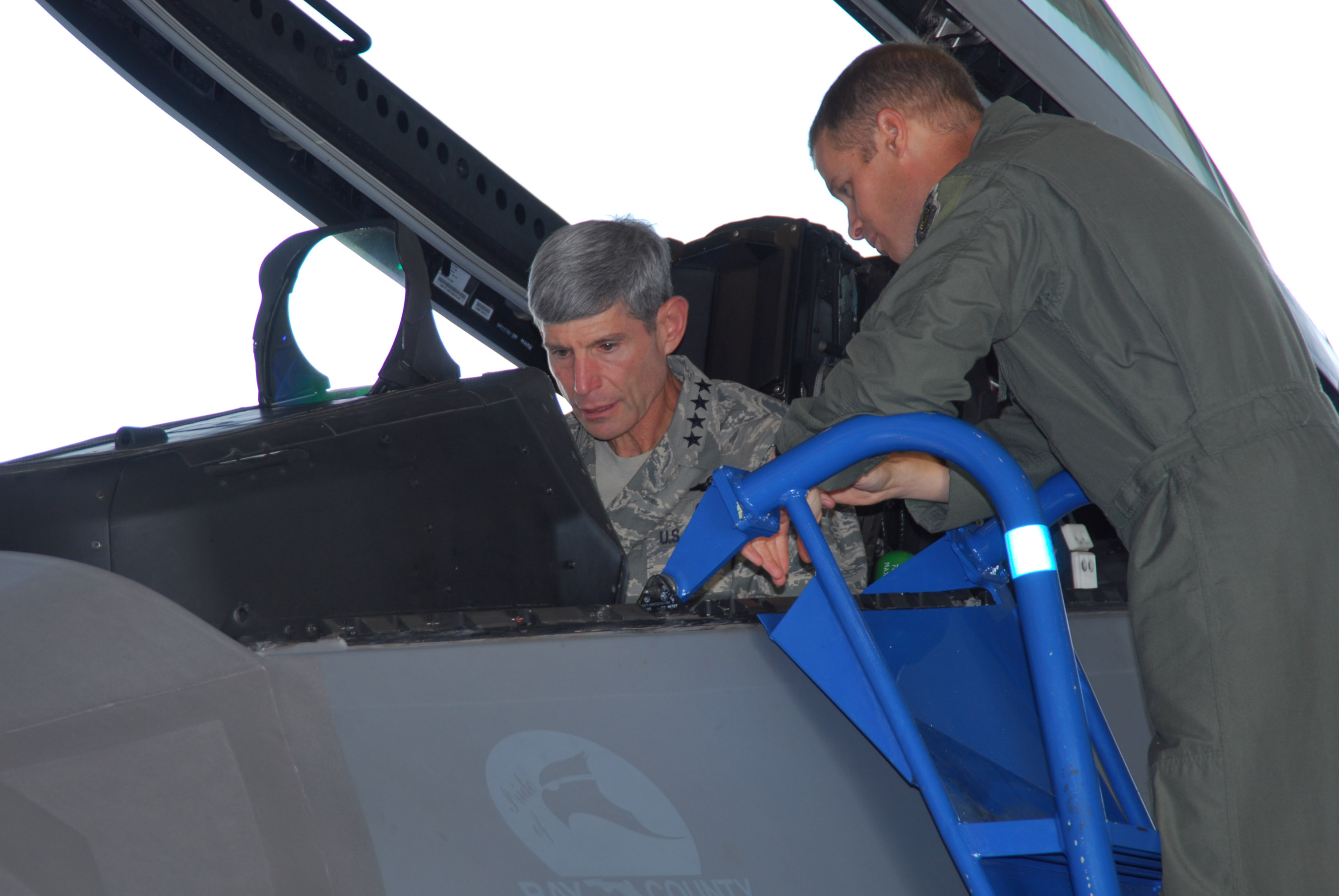R?etired Gen. Norton Schwartz, former Chief of Staff of the Air Force, shown here in an F-22, wrote in his recently released memoir that the Air Force did not push back on then-Defense Secretary Robert Gates' decision to kill the F-22 because it saw it as a losing argument and wanted to focus its efforts on getting a new bomber. Air Force photo by Lisa Norman.
The top Air Force leadership went along with former Defense Secretary Robert Gates’ termination of the F-22 fighter—after producing less than half the required number—because they believed they couldn’t win the argument and that getting approval to build a new bomber was more important.
In “Journey: Memoirs of an Air Force Chief of Staff,” now in bookstores, retired Gen. Norton Schwartz said his predecessor, retired Gen. Mike Moseley, “never gave up in his principled attempts to get those 381 F-22s,” for which Gates fired Moseley and the then-Secretary of the Air Force, Mike Wynne. Schwartz was named to replace Moseley, and Mike Donley was brought in as Wynne’s replacement.
Although there were at least a dozen internal and external studies confirming 381 as the right number of F-22s, “I wanted an independent assessment to determine the minimum number,” Schwartz wrote, “and what we came up with” was 243 aircraft. Gates rejected that number too, “even though we had shaved over 35 percent off the Moseley/Wynne demand for 381,” Schwartz said. That difference of 60 airplanes would have cost “$13 billion at a time that defense budgets were being tightened,” and Gates wanted that money for “things like remotely piloted aircraft and MRAPs.”
Schwartz and Donley concluded “the F-22 debate had consumed enough oxygen and it was time to move on,” Schwartz said, and the two were “certainly not going to go to the Hill behind Secretary Gates’s back and lobby for more … That was never going to happen on our watch.” Schwartz acknowledged that some thought this “too pristine a judgement,” and that “anything in Washington is fair, but I say no. I had never been disloyal to a boss and I wasn’t about to start then.” Schwartz wrote extensively in the book about how Gates fought for Schwartz’ nomination to be Chief against congressional resistance.
Gates, in his own memoir, “Duty,” argued that the F-22 was useless in the Afghanistan and Iraq counterinsurgencies, was a Cold War relic, and that a Chinese stealth fighter wouldn’t be along until the 2020s, so nothing would be lost by killing it. In actual fact, the F-22 has been essential in the Syria campaign and China fielded its first operational stealth squadron in 2017. Every Air Combat Command chief since Gates tenure has warned that the F-22 force is far too small for the demands placed on it.
There was “a method to our madness,” Schwartz continued. “We felt that the real coin of the realm was the replacement bomber” and “we had our work cut out for us” convincing a “very skeptical civilian leadership” that the B-1 and B-52 would not last forever, that the B-2 fleet was too small, and that a replacement aircraft, in numbers, was urgently needed.Gates terminated the Next-Generation Bomber—the project preceding what’s now known as the B-21—for what Schwartz agreed were “rational reasons.” The NGB “had grown too big” and was carrying too many missions and requirements. It was to have an air-to-air missile capability for self defense, Schwartz revealed, describing that requirement as “not completely nonsensical” but unaffordable. The attitude was that “cost was no object” on the NGB, Schwartz claimed, and that didn’t meet with Gates’ worldview, “So he cancelled it.”
In explaining the termination of the NGB to Congress and the press, Gates claimed that the B-2’s unit cost had swelled unreasonably and this is why it had been cancelled in its day, but that was exactly backwards. It was cutting the planned 132 B-2s to 20 that caused its unit cost to swell, because all of the research and development costs associated with it had to be amortized across a force less than a sixth as large as had been planned.
Nevertheless, Schwartz and Donley believed there was a “valid need” for a new bomber; an “unquestioned requirement” to provide such an option for a future president, “both for warfighting and deterrence purposes.” Schwartz and Donley had to convince Gates the Air Force “would not repeat the experience of the B-2.” They argued that USAF had to have 80-100 new bombers, and the service would swear to keep the cost as the prime consideration and not break a ceiling of $550 million in 2010 dollars. Moreover, they promised the aircraft would rely heavily on offboard sensors, jammers, and other capabilities to keep the cost down, as part of a system of systems.
“We had to convince him of all of this, or like the [NGB], the long-range strike bomber would be dead in the water,” Schwartz asserted. Ultimately, Gates relented, apparently persuaded that “we as an Air Force could field such a system with discipline.” Schwartz said he and Donley are proud of having “succeeded in persuading Gates” the B-21 would be pursued with “discipline like he had not seen, and so it’s up to our successors to deliver on that promise. The Air Force has to, if it is going to bring this one home.”
